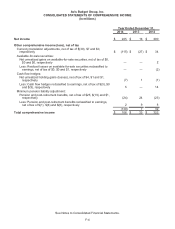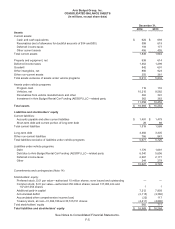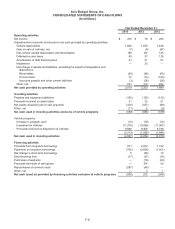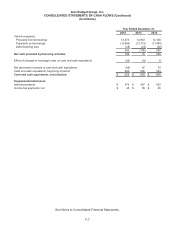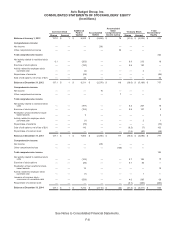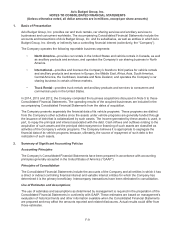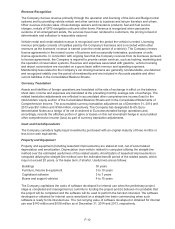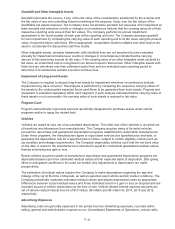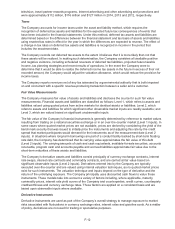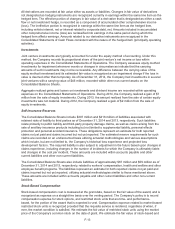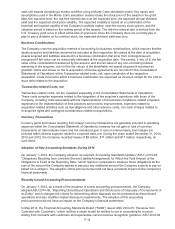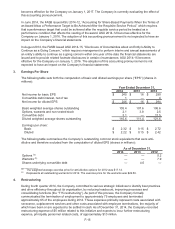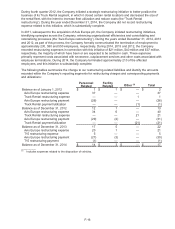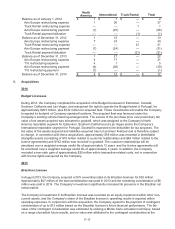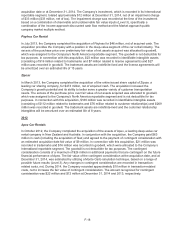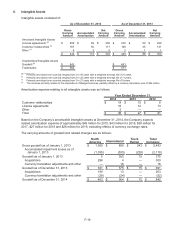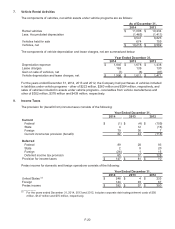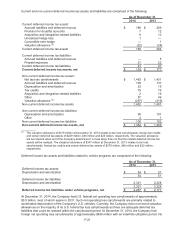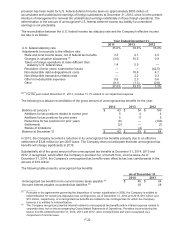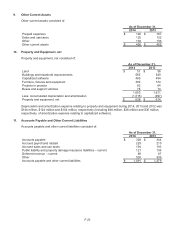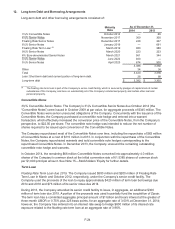Avis 2014 Annual Report Download - page 81
Download and view the complete annual report
Please find page 81 of the 2014 Avis annual report below. You can navigate through the pages in the report by either clicking on the pages listed below, or by using the keyword search tool below to find specific information within the annual report.F-14
cash unit awards containing a market condition using a Monte Carlo simulation model. Key inputs and
assumptions used in the Monte Carlo simulation model include the stock price of the award on the grant
date, the expected term, the risk-free interest rate over the expected term, the expected annual dividend
yield and the expected stock price volatility. The expected volatility is based on a combination of the
historical and implied volatility of the Company’s publicly traded, near-the-money stock options, and the
valuation period is based on the vesting period of the awards. The risk-free interest rate is derived from the
U.S. Treasury yield curve in effect at the time of grant and, since the Company does not currently pay or
plan to pay a dividend on its common stock, the expected dividend yield was zero.
Business Combinations
The Company uses the acquisition method of accounting for business combinations, which requires that the
assets acquired and liabilities assumed be recorded at their respective fair values at the date of acquisition.
Assets acquired and liabilities assumed in a business combination that arise from contingencies are
recognized if fair value can be reasonably estimated at the acquisition date. The excess, if any, of (i) the fair
value of the consideration transferred by the acquirer and the fair value of any non-controlling interest
remaining in the acquiree, over (ii) the fair values of the identifiable net assets acquired is recorded as
goodwill. Gains and losses on the re-acquisition of license agreements are recorded in the Consolidated
Statements of Operations within Transaction-related costs, net, upon completion of the respective
acquisition. Costs incurred to effect a business combination are expensed as incurred, except for the cost to
issue debt related to the acquisition.
Transaction-related Costs, net
Transaction-related costs, net are classified separately in the Consolidated Statements of Operations.
These costs comprise expenses related to the integration of the acquiree’s operations with those of the
Company, including costs associated with the implementation of incremental compliance-related programs,
expenses for the implementation of best practices and process improvements, expenses related to
acquisition-related activities such as due-diligence and other advisory costs, non-cash charges related to
re-acquired rights and contingent consideration related to acquisitions.
Currency Transactions
Currency gains and losses resulting from foreign currency transactions are generally included in operating
expenses within the Consolidated Statement of Operations; however the net gain or loss of currency
transactions on intercompany loans and the unrealized gain or loss on intercompany loan hedges are
included within interest expense related to corporate debt, net. During the years ended December 31, 2014,
2013 and 2012, the Company recorded losses of $9 million, $11 million and $17 million, respectively, on
such items.
Adoption of New Accounting Standards During 2014
On January 1, 2014, the Company adopted, as required, Accounting Standards Update (“ASU”) 2013-04,
“Obligations Resulting from Joint and Several Liability Arrangements for Which the Total Amount of the
Obligations Is Fixed at the Reporting Date,” which requires companies to measure these obligations as the
sum of the amount the Company agreed to pay plus any additional amount the Company expects to pay on
behalf of co-obligors. The adoption of this pronouncement did not have a material impact on the Company’s
financial statements.
Recently Issued Accounting Pronouncements
On January 1, 2015, as a result of the issuance of a new accounting pronouncement, the Company
adopted ASU 2014-08, “Reporting Discontinued Operations and Disclosures of Disposals of Components of
an Entity,” which changes the criteria for determining which disposals can be presented as discontinued
operations and also modifies related disclosure requirements. The adoption of this accounting
pronouncement did not have an impact on the Company’s financial statements.
In May 2014, the Financial Accounting Standards Board (“FASB”) issued ASU 2014-09, “Revenue from
Contracts with Customers,” which outlines a single model for entities to use in accounting for revenue
arising from contracts with customers and supersedes current revenue recognition guidance. ASU 2014-09


